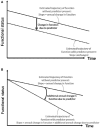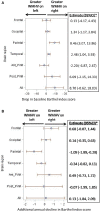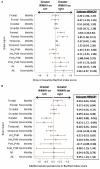Differential Effect of Left vs. Right White Matter Hyperintensity Burden on Functional Decline: The Northern Manhattan Study
- PMID: 28970793
- PMCID: PMC5609109
- DOI: 10.3389/fnagi.2017.00305
Differential Effect of Left vs. Right White Matter Hyperintensity Burden on Functional Decline: The Northern Manhattan Study
Abstract
Asymmetry of brain dysfunction may disrupt brain network efficiency. We hypothesized that greater left-right white matter hyperintensity volume (WMHV) asymmetry was associated with functional trajectories. Methods: In the Northern Manhattan Study, participants underwent brain MRI with axial T1, T2, and fluid attenuated inversion recovery sequences, with baseline interview and examination. Volumetric WMHV distribution across 14 brain regions was determined separately by combining bimodal image intensity distribution and atlas based methods. Participants had annual functional assessments with the Barthel index (BI, range 0-100) over a mean of 7.3 years. Generalized estimating equations (GEE) models estimated associations of regional WMHV and regional left-right asymmetry with baseline BI and change over time, adjusted for baseline medical risk factors, sociodemographics, and cognition, and stroke and myocardial infarction during follow-up. Results: Among 1,195 participants, greater WMHV asymmetry in the parietal lobes (-8.46 BI points per unit greater WMHV on the right compared to left, 95% CI -3.07, -13.86) and temporal lobes (-2.48 BI points, 95% CI -1.04, -3.93) was associated with lower overall function. Greater WMHV asymmetry in the parietal lobes (-1.09 additional BI points per year per unit greater WMHV on the left compared to right, 95% CI -1.89, -0.28) was independently associated with accelerated functional decline. Conclusions: In this large population-based study with long-term repeated measures of function, greater regional WMHV asymmetry was associated with lower function and functional decline. In addition to global WMHV, WHMV asymmetry may be an important predictor of long-term functional status.
Keywords: MRI and fMRI; disability; subclinical ischemia; trajectory; white matter hyperintensities.
Figures




References
-
- Andersson J. L., Smith S. M., Jenkinson M. (2008). Fnirt— fmrib's non-linear image registration tool, in Annual Meeting of the Organization Hum Brain Mapp (Melbourne, VIC: ).
Grants and funding
LinkOut - more resources
Full Text Sources
Other Literature Sources

